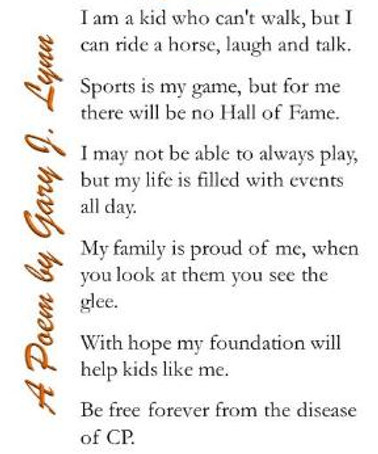

About CP
MISSION
About Cerebral Palsy
Cerebral Palsy can’t be cured, but treatment will often improve a child's capabilities. Many children go on to enjoy near-normal adult lives if their disabilities are properly managed. In general, the earlier treatment begins the better chance children have of overcoming developmental disabilities or learning new ways to accomplish the tasks that challenge them.
Treatment may include physical and occupational therapy, speech therapy, drugs to control seizures, relax muscle spasms, and alleviate pain; surgery to correct anatomical abnormalities or release tight muscles; braces and other orthotic devices; wheelchairs and rolling walkers; and communication aids such as computers with attached voice synthesizers.
The term "Cerebral Palsy" refers to any one of a number of neurological disorders that appear in infancy or early childhood and permanently affect body movement and muscle coordination but don’t worsen over time. Even though cerebral palsy affects muscle movement, it isn’t caused by problems in the muscles or nerves. It is caused by abnormalities in parts of the brain that control muscle movements. The majority of children with cerebral palsy are born with it, although it may not be detected until months or years later.
The early signs of Cerebral Palsy usually appear before a child reaches 3 years of age. The most common are a lack of muscle coordination when performing voluntary movements (ataxia); stiff or tight muscles and exaggerated reflexes (spasticity); walking with one foot or leg dragging; walking on the toes, a crouched gait, or a “scissored” gait; and muscle tone that is either too stiff or too floppy. A small number of children have cerebral palsy as the result of brain damage in the first few months or years of life, brain infections such as bacterial meningitis or viral encephalitis, or head injury from a motor vehicle accident, a fall, or child abuse.
What is Cerebral Palsy? Is There Any Treatment?
Cerebral palsy doesn’t always cause profound disabilities. While one child with severe cerebral palsy might be unable to walk and need extensive, lifelong care, another with mild cerebral palsy might be only slightly awkward and require no special assistance. Supportive treatments, medications, and surgery can help many individuals improve their motor skills and ability to communicate with the world.
What is the prognosis?
Cerebral palsy doesn’t always cause profound disabilities. While one child with severe cerebral palsy might be unable to walk and need extensive, lifelong care, another with mild cerebral palsy might be only slightly awkward and require no special assistance. Supportive treatments, medications, and surgery can help many individuals improve their motor skills and ability to communicate with the world.

TIRR Robotics
TIRR Memorial Hermann is a leader in research and technology to assist in our patient’s rehabilitation.
